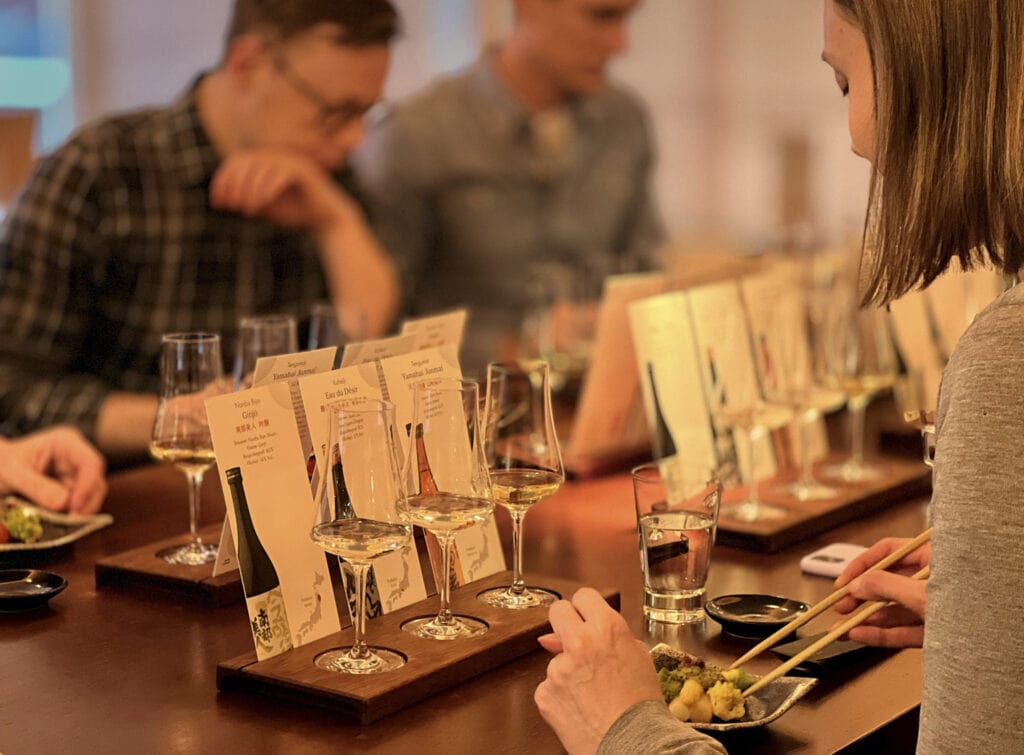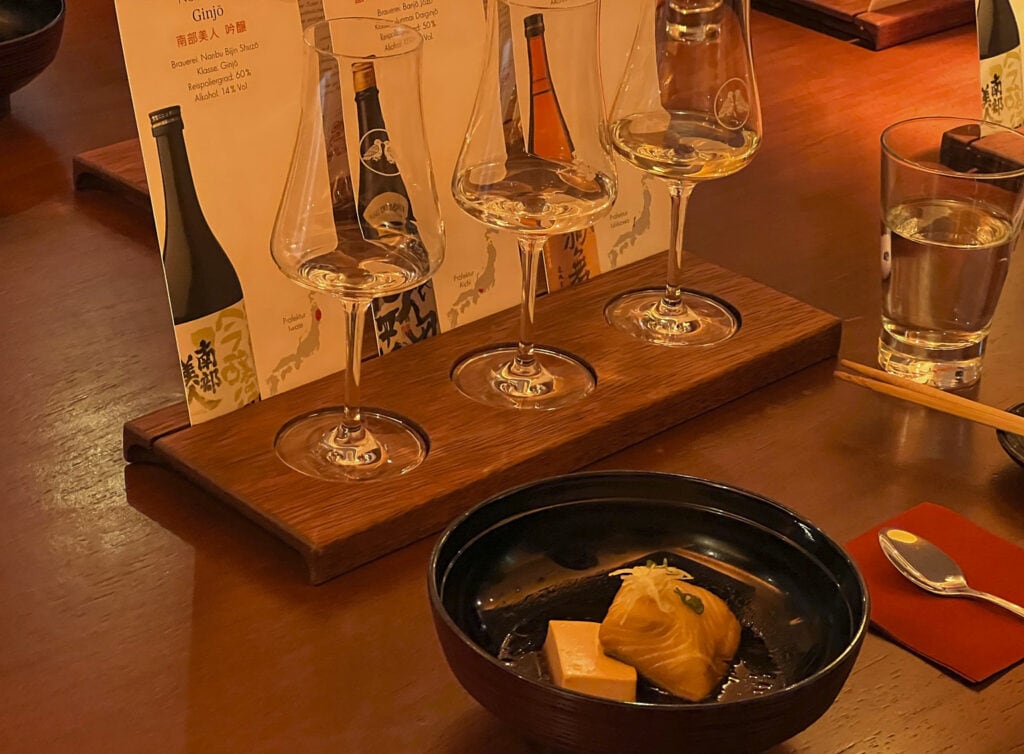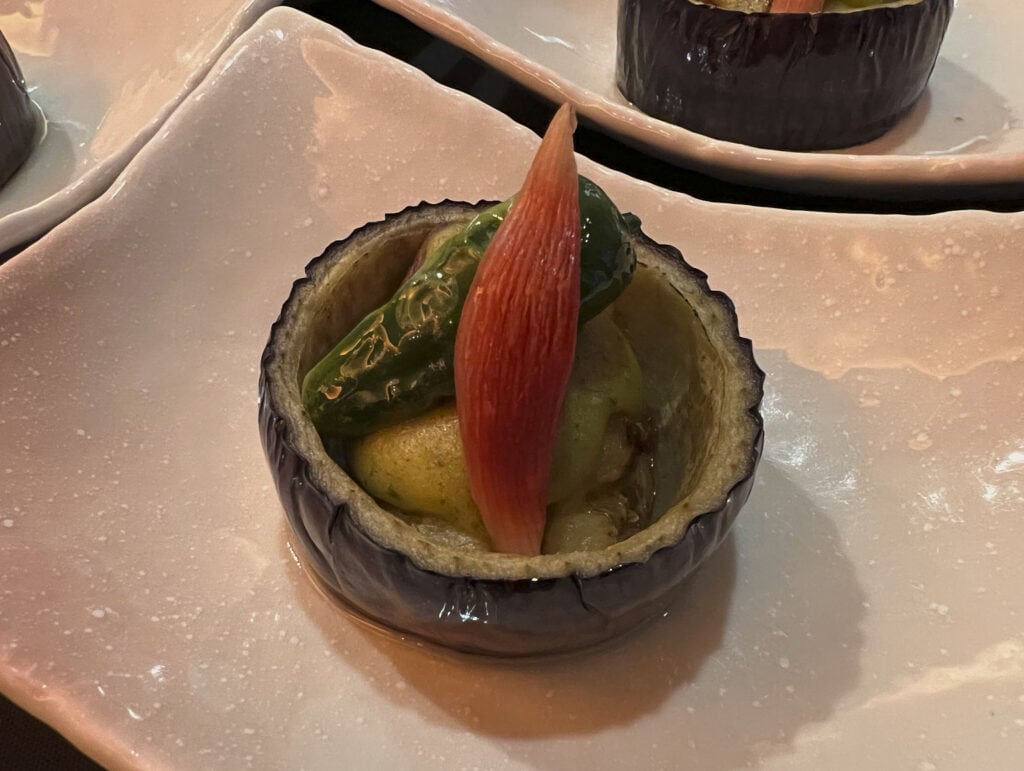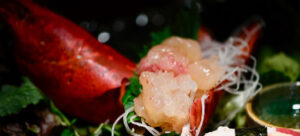On March 17, we had the opportunity to celebrate the end of a day of workshops by a small but select business group with a small, individual sake mini-tasting.
Our menu for mini sake tasting on 17.03.2022
For this, our kitchen and our service team have coordinated to develop three small, very special appetizers, which will be served to three Sake fit, which our group was introduced to by our sake expert Natsuyo.
Here's a little insight into the menu and the extensive handiwork that is always behind Japanese cuisine as we understand it.

White asparagus, romanesco broccoli and cocktail tomatoes, with a delicate topping of crushed shiso in midori-zu (緑酢, green vinegar) and anchovies.
The white asparagus and Romaneso are "Hashiri" (走り), that is, in the beginning of their respective seasons.
Midori-zu is made by grating cucumber and combining it with shiso and sanbai-zu (三杯酢, literally three cups of vinegar).
The greenish taste of the cucumber is transformed by the vinegar into a refreshing aroma, and the sweetness of each vegetable is enhanced. It is accentuated by the salty taste of anchovies. The combination of white asparagus, green romanesco and red tomatoes expresses the arrival of spring. This principle of reflecting typical spring colors in food is loved by the Japanese -. perhaps some of our customers still remember the Sanshoku Dango, which in the 2021 Easter Special... already anticipated the colors of spring. at that time, of course, with a clear pink of cherry blossoms instead of the red of tomatoes today.
Sanbai-zu, by the way, is made from a combination of light Soy sauce, cooked mirin, and rice vinegar, and is a versatile sauce for dishes that require a tart flavor.
This was accompanied by the sake of the category and the name "Ginjō" from the Nanbu Bijin Brewery. For the seasonal vegetable dishes that heralded spring, one of the freshest and lightest sake was chosen.
Ginjō-Shu is recommended as the first sake for sake beginners, because it proves that sake does not taste like tasteless liquor, but is extremely aromatic and delicious. Guests quickly noticed that it is very fruity.
Boiled black cod, tofu, mitsuba, thinly sliced ginger.
The fatty Black Cod (銀鱈, Gindara, black cod) is carefully cooked in a sauce flavored with sake, soy sauce and mirin (sweet sake and mirin). The short cooking time preserves the fish's flavor and soft and fluffy texture perfectly. When cooking fish, it is important to eliminate the fish odor so that the fish does not fall apart, and to season it finely so that the flavors of the ingredients are brought out. This is not easy to do and so it is here that the skill of an experienced chef shows itself. The tofu is cooked separately in the fish broth so that the fish broth can be enjoyed to the fullest.
The bright, white, oily Black Cod, which lives in relatively deep waters, goes well with steamed fish.

As a second sake we had for the guests to accompany the Black Cod a Junmai Daiginjō prepared by Kuheiji called "Eau de Désir".
It was immediately clear that this sake had a higher intensity than the first, with a complex interplay of five flavors. This sake is an example of the modern type of sake that also accompanies French cuisine. Guests were delighted with the drinking experience, which reminded them of white wine.
Kinome dengaku (木の芽田楽), baked eggplant and beef and pimiento padron and myoga (茗荷, Japanese ginger).
Eggplants are hollowed out, briefly fried in oil and baked in the oven with raw beef and kinome miso. Kinome miso , a typical spring sauce of Japanese cuisine, is a mixture of saikyo miso, egg yolk, sake and mirin that is slowly moistened in a hot water bath and then mixed with grated kinome (木の芽 shoots of Sanshō leaves). The gentle sweetness of Saikyo Miso and the fragrance of Kinome, which for Japanese already heralds spring, go well with eggplant and beef.
The name "Dengaku" comes from a custom dating back to the Heian period (794-1185), in which people in farming villages prayed for a good harvest: "Dengaku-mai" (田楽舞, means Dengaku dance). In this "Dengaku-mai", the dancers wear white hakama and jump on a single stick. From then on, the name "dengaku" was used for a dish in which ingredients are skewered and miso is poured over them. Later, dishes that are not skewered but cooked with miso sauce were also called dengaku.
Originally a tofu dish, it is now often made with eggplant, satoimo (a type of taro), figs, konnyaku, bamboo shoots, and other ingredients that go well with miso.

For the third course the guests tried a Junmaishu "Tengumai" from the Shata Brewery. This sake again offered a very different taste than the previous two - it's one of our sous chef Natsuko's favorites. This sake is full-bodied and has a mushroomy, earthy flavor that goes well with dishes made with miso. It was then exciting for us to see how each sake found its one fan among the group of six - and how a discussion developed about which of the sakes tasted best to whom or went best with what.
Interested in an event? We are too!
We are always excited about such opportunities, as it gives us the chance to make something special out of the vast repository of Japanese cuisine, our unique sake selection, and seasonal conditions.
If you are also interested in an individual event, please contact us via our Contact form.







